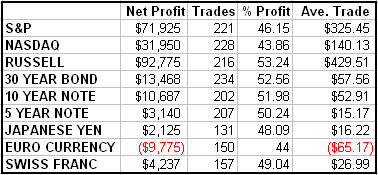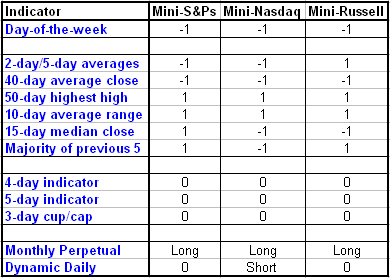If a market fails to push through in one direction, it will inevitably make a run at the other side. This is a widely held axiom that makes intuitive sense. The job of markets, after all, is to attract buyers and sellers through movement. A brick wall will only be stormed so many times.
That's kind of the theory behind a day trading bias I've uncovered that basically looks to a series of lows for long confirmation and vice versa for highs. Specifically:
For the last three days, if the highest low minus the lowest low is less than or equal to 20 percent of the total three-day range, buy the next open. If the highest high minus the lowest high is less than or equal to 20 percent of the total three-day range, sell short on the open. Exit both on the close.
Here are the results.

The Biases
Continue to hold longs in the mini S&Ps and mini Russell. In the Nasdaq, flip to the short side on the open.

The bottom two rows determine the signal. Dynamic Day One trumps everything‚Ä"you always follow it. When it's neutral, the Monthly Perpetual provides the direction.
DISCLAIMER: It should not be assumed that the methods, techniques, or indicators presented on in this column will be profitable or that they will not result in losses. Past results are not necessarily indicative of future results. Examples presented on this column are for educational purposes only. These set-ups are not solicitations of any order to buy or sell. The author, Tiger Shark Publishing LLC, and all affiliates assume no responsibility for your trading results. There is a high degree of risk in trading.
Art Collins is the author of Market Beaters, a collection of interviews with renowned mechanical traders. He is currently working on a second volume. E-mail Art at artcollins@ameritech.net.